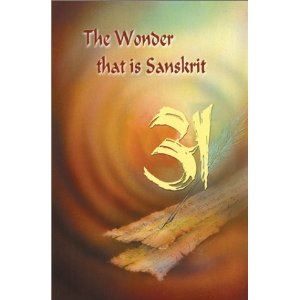
Sanskrit is a language of antiquity. The roots of many languages of the world are found in Sanskrit. It is often called the Mother of languages, Sarvabhasajanani. Tradition tells us that in the Sanskrit language there is a perfect and harmonious relationship between sound and sense, for here the sound and sense are inseparable. This relationship is based on some eternal principles. Sri Aurobindo recognises this very characteristic feature of Sanskrit and says – “The Sanskrit language is the ‘Devabhasa’… It is the language of Satya Yuga based on the true and perfect relation of vak and artha. Every one of its vowels and consonants has particular and inalienable force which exists by the nature of things and not by development or human choice;…” [Sri Aurobindo: ‘Hymns to the Mystic Fire’, SABCL Vol.11, p. 449]
Sanskrit is capable of expressing all types of feelings, ideas and thoughts in a perfect manner which cannot be done as perfectly in any other language. Due to its vast creative possibilities it is also capable of expressing precisely and minutely abstract thoughts as well as the most profound and sublime ideas. Sri Aurobindo observed that this language “is one of the most magnificent, the most perfect and wonderfully sufficient literary instruments developed by human mind;…”[ Sri Aurobindo: ‘The Foundations of Indian Culture’, SABCL Vol.14, p. 255] He describes Sanskrit as the ‘language of Yoga’, and adds that the supreme experiences and unusual conceptions which are a part of yogic experience are “difficult to represent accurately in any other language than the ancient Sanskrit tongue in which alone they have been to some extent systematised.” [Sri Aurobindo: ‘The Synthesis of Yoga’, SABCL Vol.20, pp. 11-12]
Sanskrit is “at once majestic and sweet and flexible, strong and clearly formed and full and vibrant and subtle,…”[ Sri Aurobindo: ‘The Foundations of Indian Culture’, SABCL Vol.14, p. 255] One can find in the works of Vyasa, Valmiki, Kalidasa, Bharavi, Magha, Sivasvami, Banabhatta, Bhavabhuti, the majesty of Sanskrit language and in the works of Sriharsa, Dandi and Jayadeva, its sweetness. The flexibility of this language can clearly be observed in the Citrakavya or figurative literature. Strength and structural perfection are seen in almost all the literary works of Sanskrit. One can feel the subtle vibration of the sounds in the Mantras of the Vedas and the Upanishads and the stotras written by the seer poets. The philosophical texts and other Shastras reveal its utmost subtlety.
Sanskrit is the language in which India’s real soul is reflected. It is the language of its culture and people. It is the National inheritance of this country. The contribution of it to the national life and culture of India is incomparable. It is not only a symbol of national pride and unity and harmony but also much of India’s future rests on this classical language and without it India would find it difficult to progress. Sri Aurobindo points out that “Sanskrit ought still to have a future as a language of the learned and it will not be a good day for India when the ancient tongue ceases entirely to be written or spoken.” [Sri Aurobindo: ‘The Hour of God’, SABCL Vol.17, p. 299]
Sanskrit can be a tremendous unifying force. It is also capable of bringing an end to the language problem of India and according to Sri Aurobindo should be its National Language. The Mother says, “The ideal would be in a few years, to have a rejuvenated Sanskrit as the representative language of India, that is a spoken Sanskrit. Sanskrit is behind all the languages of India and it should be that. This was Sri Aurobindo’s idea when we spoke about it… here as soon as one begins to want a National language, everyone starts quarrelling. Each one wants it to be his own and that is foolish. But no one could object to Sanskrit.” [The Mother. 11. 11. 1967]
A simple spoken Sanskrit rather than that of scholars is necessary to enter the heart of our glorious culture and establish a continuity between the past and the future. In Sri Aurobindo’s words – “… but the vital question is how we are to learn and make use of Sanskrit and the indigenous languages so as to get to the heart and intimate sense of our own culture and establish a vivid continuity between the still living power of our past and the yet uncreated power of our future,…”[ Sri Aurobindo: ‘The Hour of God’, SABCL Vol.17, p. 195] The Mother gave much importance to the use of simple Sanskrit. [The Mother. 11. 11. 1967] In fact she herself kept learning Sanskrit whenever she got the time.[The Mother. Vol.12, p. 24, p. 11] In her opinion a knowledge of Sanskrit was necessary for anyone who claimed to be an Indian; so she emphatically said that “every child born in India should know it, just as every child born in France has to know French.”[ The Mother. 11. 11. 1967]
(Compiled from the book “The Wonder that is Sanskrit” authored by Sampad and Vijay)





